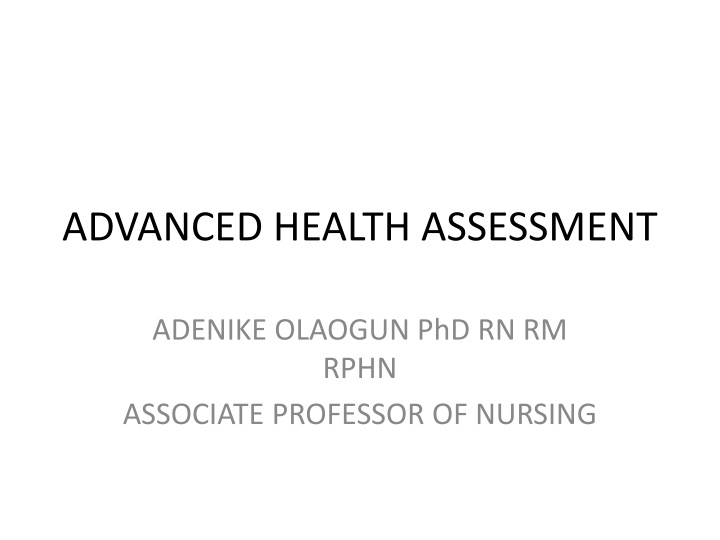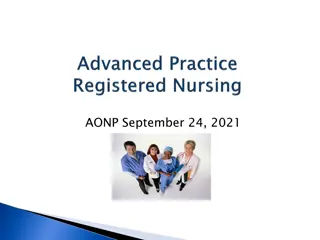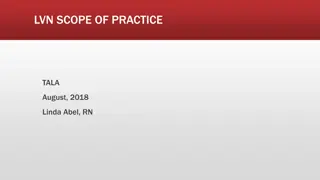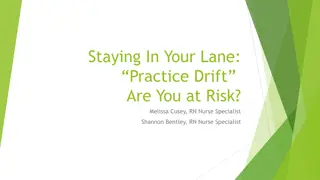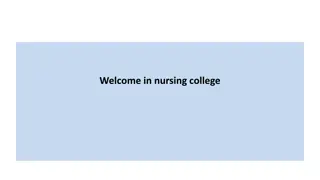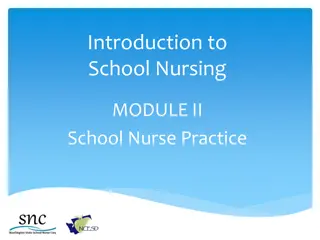Comprehensive Overview of Advanced Health Assessment in Nursing Practice
This comprehensive guide explores the essential components of health assessment in nursing, covering definitions, types, tools, and processes involved. Learn about the importance of health assessment in identifying nursing diagnoses, planning care, and promoting overall well-being for clients. Dive into the foundational principles that guide nurses in gathering and analyzing critical information to deliver quality care.
Download Presentation

Please find below an Image/Link to download the presentation.
The content on the website is provided AS IS for your information and personal use only. It may not be sold, licensed, or shared on other websites without obtaining consent from the author.If you encounter any issues during the download, it is possible that the publisher has removed the file from their server.
You are allowed to download the files provided on this website for personal or commercial use, subject to the condition that they are used lawfully. All files are the property of their respective owners.
The content on the website is provided AS IS for your information and personal use only. It may not be sold, licensed, or shared on other websites without obtaining consent from the author.
E N D
Presentation Transcript
ADVANCED HEALTH ASSESSMENT ADENIKE OLAOGUN PhD RN RM RPHN ASSOCIATE PROFESSOR OF NURSING
Learning Objectives At the end of this learning session, the learner will be able to ; 1. Define Health Assessment 2. Identify the various types of assessment 3. Identify the tools used in Health Assessment 4. Describe how to assess clients and make nursing diagnoses,
Introduction Nursing practice revolves around the nurse client relationship. Based on the therapeutic use of self through verbal and nonverbal communication skills. The nurse has a privileged role as a respected care provider. In some situations, patients disclose information to nurses not even shared with family members.
Introduction The nurse learns wide-ranging things about clients from minute physical details to deep- seated feelings about spirituality, culture, and psychosocial concerns. Health assessment is the bedrock for identifying appropriate nursing diagnoses, projecting nursing outcomes and selecting appropriate nursing interventions that will result in the provision of quality care to clients
Definition of Health Assessment It is a systematic deliberate and interactive process by which nurses use critical thinking to collect, validate, analyze and synthesise the collected information in order to make judgment about the health status and life processes of individuals, communities. (Nursing Council of Hong Kong, 2006) families and
ASSESSMENT Definition; It is the process of collecting data that provides information about the client s health care needs. Foundation for approaching care. Primary source of data is the client. The Client is an individual, family, community or group/ organization. Types; Comprehensive, partial and Focused
Purposes of Health Assessment Obtain baseline data Support, confirm or refute data collected in the nursing history Obtain data that will be used to identify appropriate nursing diagnoses and plan care Evaluate the outcomes of care Identify areas for health promotion and disease prevention
Preparation for Health Assessment Ensure privacy Consider the especial needs of the client Have all necessary equipments
Components of Assessment Individual/ Family 1. Nursing history, 2. Physical assessment, 3. Review of the patient/client s record. 4 .Hold consultation with patient/client s support persons and healthcare professionals 5. Results of laboratory and diagnostic tests.
Nursing History 1. Biographic data 2. Complaint or reason for coming to health facility 3. History of present illness 4. Past health history 5. Family history of illness 6. Lifestyle
Nursing History 7. Social data 8.Home and Neighborhood 9.Psychological history 10. Patterns of health care
Tools for taking Nursing History Therapeutic interaction - is a process in which the nurse ensures that the interaction focuses on the patient and the patient s concerns. Key elements include caring and empathy Interview Observation
Skills Required Active listening Reflection Encouraging elaboration (facilitation) Purposive silence Clarification Summarising
Interview Process Pre interaction phase Beginning phase Working phase- Use of closed ended questions ( direct) and open ended questions Closing phase
BIO DATA Age, date of birth, sex, Educational level Ethnic group, Religion, Marital status Home and office address Telephone numbers Occupation / income State of origin and local govt. area. Next of kin, address and telephone number
Complaint or reason for coming to health facility Ask for the reason for coming to the health facility
History of present illness What is the present problem? When did it start? What are the signs and symptoms? Has the client used any remedy? What type of remedy? What were the effects of the remedy?
Past Medical History Any past medical / surgical problem Is s/he on any medication When and duration of such problem
Family history of illness Are there any heredity disease in the family Any history of hypersensitive reaction ?
Gordon's Functional Health Patterns is a method devised by M. Gordon to be used to provide a more comprehensive nursing assessment 1. Health perception and management 2. Nutrition and metabolism 3. Elimination 4. Activity and exercise 5. Sleep and rest 6. Cognition and perception 7. Self-perception and self-concept 8. Roles and relationships 9. Sexuality and reproduction 10.Coping and stress management 11.Values and beliefs
Health Perception and Management Perception of general health, any absence from school or work Perception of cause of current problem Actions taken to relieve current problem
Nutrition and Metabolism Typical daily food intake, use of supplements, types of snacks Food choice Food size Number of time the person eats Food allergy Food taboos Food contents
ELIMINATION Frequency, character, discomfort, Number of times per day and night. Estimated quantity Pain on micturition Incontinence Any unusual symptoms
ELIMINATION CONTD FAECES How often Constipation Painful Any unusual symptoms
Activity and Exercise Exercise pattern- type, regularity, leisure activities Perceived ability for feeding, grooming, bathing, general mobility, toileting, home maintenance, bed mobility, dressing and shopping Use of assistive device ADL
Sleep and Rest Quality and quantity Amount of sleep Rest/ relaxation Sleep problems
Cognition and Perception Assess the five senses Orientation to time place and person Level of consciousness- using Glassgow scale Check for pain using the following pneumonic- PQRST/ COLPSPAC
Glasgow Coma Scale (GCS) The GCS is an neurologic assessment tool. Best Eye Response (E) Opens eyes -Spontaneously = 4 - On voice command = 3 -To painful stimuli = 2 -No response = 1 Score:_______
Best Verbal Response (V) Alert and oriented = 5 Confused and disoriented = 4 Utters inappropriate words = 3 Incomprehensible sounds = 2 Makes no sounds = 1 Score:_________
Best Motor Response (M) Follows direction = 6 Localizes pain stimuli = 5 Flexion /Withdraws from pain = 4 Abnormal flexion to painful stimuli = 3 Abnormal extension to painful stimuli = 2 Makes no movements = 1 Score:________
Score may range from 3 (lowest neurological function) to 15 (highest function). To provide a clearer picture of the patient s neurological functioning, record the score in the following manner: Example- GCS 9/15 (E 2, V 3, M 4) @ time of the day when assessed ----This could be stated as Glasgow Coma Score 9 out of a possible 15, eye opening score 2, verbal response score 3, motor response score 4.
Interpretation in brain injury- Severe- GCS <8-9 Moderate- GCS 8 or 9- 12 Minor GCS 13
PQRST Pain Assessment P -provokes.......What provokes the pain (exertion, spontaneous onset, stress, etc.) -Point to where the pain is. Q (quality) ....Is it dull, achy, sharp, stabbing, pressing, deep, surface, etc.? Is it similar to pain you have had before? R (radiation/relief) ............Does it travel anywhere (to the jaw, back, arms, etc.)? What makes it better (position, being still)? What makes it worse (deep inspiration, movement)?
PQRST S -severity Let patient use a pain scale - signs or symptoms associated with this pain (n/v, dizziness, diaphoresis, pallor, dyspnea, abnormal vital signs, etc.) T (time/onset) ...................When did it start? Is it constant or intermittent? How long does it last? Sudden or gradual onset? Does it start after you have eaten? Frequency?
COLDSPAC- Pain Assessment Character Onset Location Duration Severity Pattern Associated factors
Pain Assessment Scales MADE AVAILABLE IN A PDF DOCUMENT
Self-perception and Self-concept Attitude about self- How do you describe your self Changes in way you feel about yourself, or changes from illness Image, identity, sense of worth Emotional pattern Facial expressions, assertive or passive Non verbal cues to altered self
Roles and Relationships Family structure Role engagements and relationship
Sexuality and Reproduction Patterns of satisfaction or dissatisfaction with sexuality Menstrual history Self breast/ testicular examinations Fertility control methods Reproductive pattern
Coping and Stress Management Expressions of stress Identified stressors Usual coping mechanism Family/ group support Community resources
Values and Beliefs Values, goals, beliefs Religion preferences Spirituality Do Not Resuscitate (DNR) Choices or decisions
Physical Assessment Definition- Types- Complete ( from Head to Toe) , and Focused - Examination of body systems / Examination of a body part/ area
Methods of Examination Inspection- This is a visual assessment. It is a deliberate and purposive. Sometimes, a lighted instrument could be used to enhance the visualization.
Inspection Visual Assessment Deliberate, purposive and systematic A lighted instrument can be used to enhance visualization Inspect for moisture, colour, texture, shape, position, size, symmetry of body parts
Palpation The use of touch Two types- deep and superficial ( light)
Percussion The striking of body parts for the purpose getting sounds or vibrations
Auscultation Process of listening to body sounds Could be direct ( using unaided ear) or indirect ( using a stethoscope) i) Pitch- frequency of vibrations ii) Intensity-loudness or softness iii) Duration- length- long or short iv) Quality- whistling, gurgling or snapping
